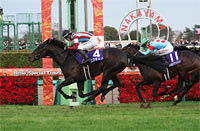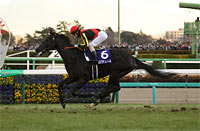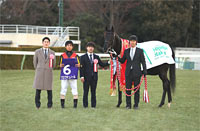Hopeful Stakes (G1) - Data Analysis
Final G1 race for 2-year-olds of the season brings together lineup of famous names in racing history
After achieving his first G1 victory in the 2019 Hopeful Stakes, Contrail won the JRA Award for Best Two-Year-Old Colt in the same year. This marked the first time a Hopeful Stakes winner secured a JRA Award at the age of 2. Contrail also went on to win the Triple Crown in 2020 with an unbeaten career record, making him only the third horse in JRA history to achieve this feat. Although it was only upgraded to G1 status in 2017, the Hopeful Stakes has already become a key race that provides important hints for later classics. Let’s now analyze some features shared by successful runners in this race based on results over the last 10 years, including the period from 2010 to 2013, when the race was held as an open-class race at Nakayama Racecourse in the same period of the year, and the period from 2014, when the Radio Nikkei Hai Nisai Stakes was moved to Nakayama Racecourse, renamed to Hopeful Stakes, and upgraded to G2 status (subsequently elevated to G1 status in 2017).
Focus on jockeys who have performed well
In recent years, non-Japanese jockeys with short-term JRA jockey’s licenses have performed well in races held around this period of the year. However, no foreign jockeys will be traveling to Japan this year due to the impact of the COVID-19 pandemic. For this reason, we looked at performances of runners in terms of JRA jockey excluding those with short-term licenses in the 10 applicable races, and found that Christophe Lemaire, who obtained a permanent JRA license in 2015, achieved an excellent Top 3 ratio of 80.0%. Incidentally, if we include the years before 2014, when Christophe Lemaire competed with a short-term JRA jockey’s license, into our analysis, his performance was [3-2-2-2] (Top 3 ratio of 77.8%). Other jockeys that have featured in the Top 3 several times include Mirco Demuro, Yuichi Fukunaga, Daichi Shibata, and Katsuharu Tanaka. [Table 1]
[Table 1] Performance by JRA jockey (10 applicable races)
| Jockey |
Performance
[1st-2nd-3rd-4th or lower] |
Win ratio |
Top 2 ratio |
Top 3 ratio |
| Christophe Lemaire |
1-1-2-1 |
20.0% |
40.0% |
80.0% |
| Mirco Demuro |
1-1-0-3 |
20.0% |
40.0% |
40.0% |
| Yuichi Fukunaga |
1-0-1-4 |
16.7% |
16.7% |
33.3% |
| Yuga Kawada |
1-0-0-2 |
33.3% |
33.3% |
33.3% |
| Daichi Shibata |
0-1-1-3 |
0% |
20.0% |
40.0% |
| Yutaka Take |
0-1-0-4 |
0% |
20.0% |
20.0% |
| Yoshitomi Shibata |
0-1-0-3 |
0% |
25.0% |
25.0% |
| Takayuki Kato |
0-1-0-0 |
0% |
100% |
100% |
| Katsuharu Tanaka |
0-0-2-1 |
0% |
0% |
66.7% |
| Masayoshi Ebina |
0-0-1-5 |
0% |
0% |
16.7% |
| Keita Tosaki |
0-0-1-4 |
0% |
0% |
20.0% |
| Yuta Nakatani |
0-0-1-0 |
0% |
0% |
100% |
| Masaki Katsuura |
0-0-1-0 |
0% |
0% |
100% |
| Other jockey |
0-0-0-70 |
0% |
0% |
0% |
Need to discount runners that contested previous race in front position
Of the 30 Top 3 finishers in the 10 applicable races, 25 were positioned “3rd or lower” when passing the 4th corner in their previous race. Conversely, runners that were positioned “2nd or higher” struggled somewhat with a Top 3 ratio of 10.2%. In other words, we should not expect too much from runners that contested their previous race in front position. [Table 2]
[Table 2] Performance by position when passing 4th corner in previous race (10 applicable races)
Position when passing 4th
corner in previous race |
Performance
[1st-2nd-3rd-4th or lower] |
Win ratio |
Top 2 ratio |
Top 3 ratio |
| 2nd or higher |
2-3-0-44 |
4.1% |
10.2% |
10.2% |
| 3rd or lower |
8-7-10-68 |
8.6% |
16.1% |
26.9% |
Watch runners with experience of winning turf race with distance of 1,800m or less at Tokyo Racecourse or Kyoto Racecourse
Of the 30 Top 3 finishers in the 10 applicable races, 16 had experience of winning “a turf race with a distance of 1,800m or less at Tokyo Racecourse or Kyoto Racecourse.” Runners in this group also achieved an excellent Top 3 ratio of 43.2%. Although the Hopeful Stakes is currently held as a turf race over a distance of 2,000m at Nakayama Racecourse, runners with experience of winning races with a shorter distance (1,800m or less) held at Tokyo Racecourse or Kyoto Racecourse have an edge. [Table 3]
[Table 3] Performance by experience of winning “turf race with distance of 1,800m or less at Tokyo Racecourse or Kyoto Racecourse” (10 applicable races)
| Experience |
Performance
[1st-2nd-3rd-4th or lower] |
Win ratio |
Top 2 ratio |
Top 3 ratio |
| Yes |
6-5-5-21 |
16.2% |
29.7% |
43.2% |
| No |
4-5-5-91 |
3.8% |
8.6% |
13.3% |
Focus on runners with either 2 or more wins or 1 career start
Of the 18 Top 3 finishers since 2014, 12 had experience of winning a “1-win class JRA or higher-grade race.” Conversely, runners without such experience struggled somewhat with a Top 3 ratio of 10.2%. We should therefore lower our expectations of runners with only “1 win” in a newcomer or maiden race. [Table 4]
[Table 4] Performance by experience of winning “1-win class JRA or higher-grade race” (last 6 years)
| Experience |
Performance
[1st-2nd-3rd-4th or lower] |
Win ratio |
Top 2 ratio |
Top 3 ratio |
| Yes |
4-5-3-15 |
14.8% |
33.3% |
44.4% |
| No |
2-1-3-53 |
3.4% |
5.1% |
10.2% |
Moreover, among runners without experience of winning a “1-win class JRA or higher-grade race,” runners with “2 or more” career starts struggled with a Top 3 ratio of 4.1%. In addition to runners that have won two or more JRA races, we should focus on runners with 1 career start (one start, one win). [Table 5]
[Table 5] Among runners without experience of winning a “1-win class JRA or higher-grade race,” performance by total career starts (last 6 years)
| Total careers starts |
Performance
[1st-2nd-3rd-4th or lower] |
Win ratio |
Top 2 ratio |
Top 3 ratio |
| 1 |
2-0-2-6 |
20.0% |
20.0% |
40.0% |
| 2 or more |
0-1-1-47 |
0% |
2.0% |
4.1% |
Check closing speed in races held since October
Of the 18 Top 3 finishers since 2014, 16 had experience of “ranking 2nd or higher in the estimated time over the final three furlongs in a JRA turf race they won since October.” Runners in this group also achieved an outstanding Top 3 ratio of 41.0%. When looking at the track record of this year’s runners, we should check the closing speed in races held since October. [Table 6]
[Table 6] Performance by experience of “ranking 2nd or higher in estimated time over final three furlongs in JRA turf race won since October” (last 6 years)
| Experience |
Performance
[1st-2nd-3rd-4th or lower] |
Win ratio |
Top 2 ratio |
Top 3 ratio |
| Yes |
6-4-6-23 |
15.4% |
25.6% |
41.0% |
| No |
0-2-0-45 |
0% |
4.3% |
4.3% |
Seek out the winner!
Runners that were highly favored in previous race are strong performers
All six recent winners had contested their previous race while backed as 2nd favorite or higher. This suggests we should lower our expectations of runners that have contested their previous race while backed as 3rd favorite or lower. Another feature shared by these six winners was they had experience of “ranking 2nd or higher in the estimated time over the final three furlongs in a JRA turf race they won since October.” In other words, we should also focus on the trend shown in Table 6. [Table 7]
[Table 7] Winners’ favoritism in previous race, and number of times “ranked 2nd or higher in estimated time over final three furlongs in JRA turf race won since October” (last six years)
| Year |
Winner |
Favoritism in
previous race |
Number of times “ranked 2nd or higher in estimated
time over final three furlongs in JRA turf race
won since October” |
| 2014 |
Shining Lei |
2nd favorite |
Once (2yo newcomer) |
| 2015 |
Hartley |
1st favorite |
Once (2yo newcomer) |
| 2016 |
Rey de Oro |
1st favorite |
Twice (Habotan Sho, etc.) |
| 2017 |
Time Flyer |
1st favorite |
Once (Hagi Stakes) |
| 2018 |
Saturnalia |
1st favorite |
Once (Hagi Stakes) |
| 2019 |
Contrail |
1st favorite |
Once (Tokyo Sports Hai Nisai Stakes) |
(Masaya Ibuki)
|



















